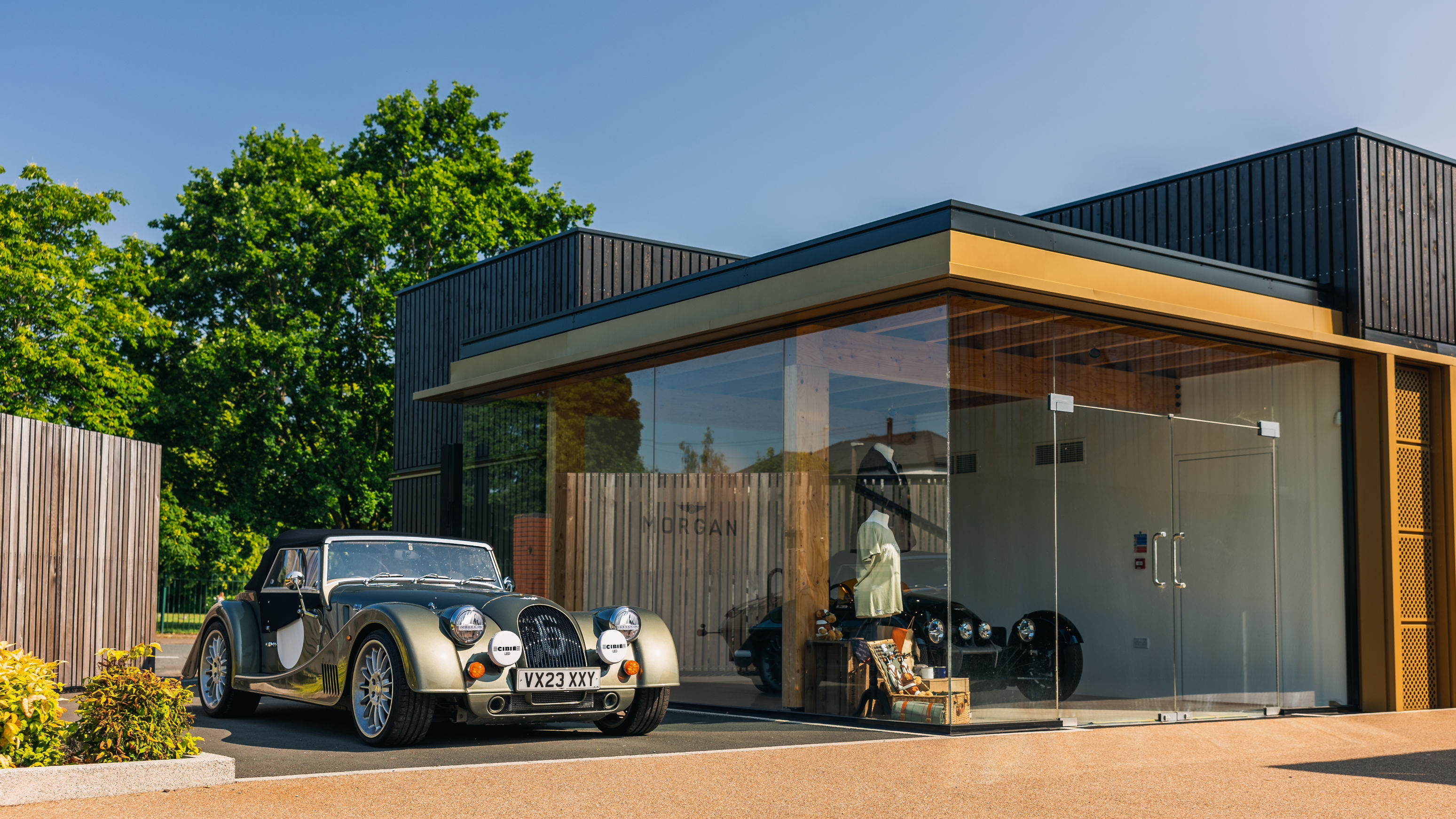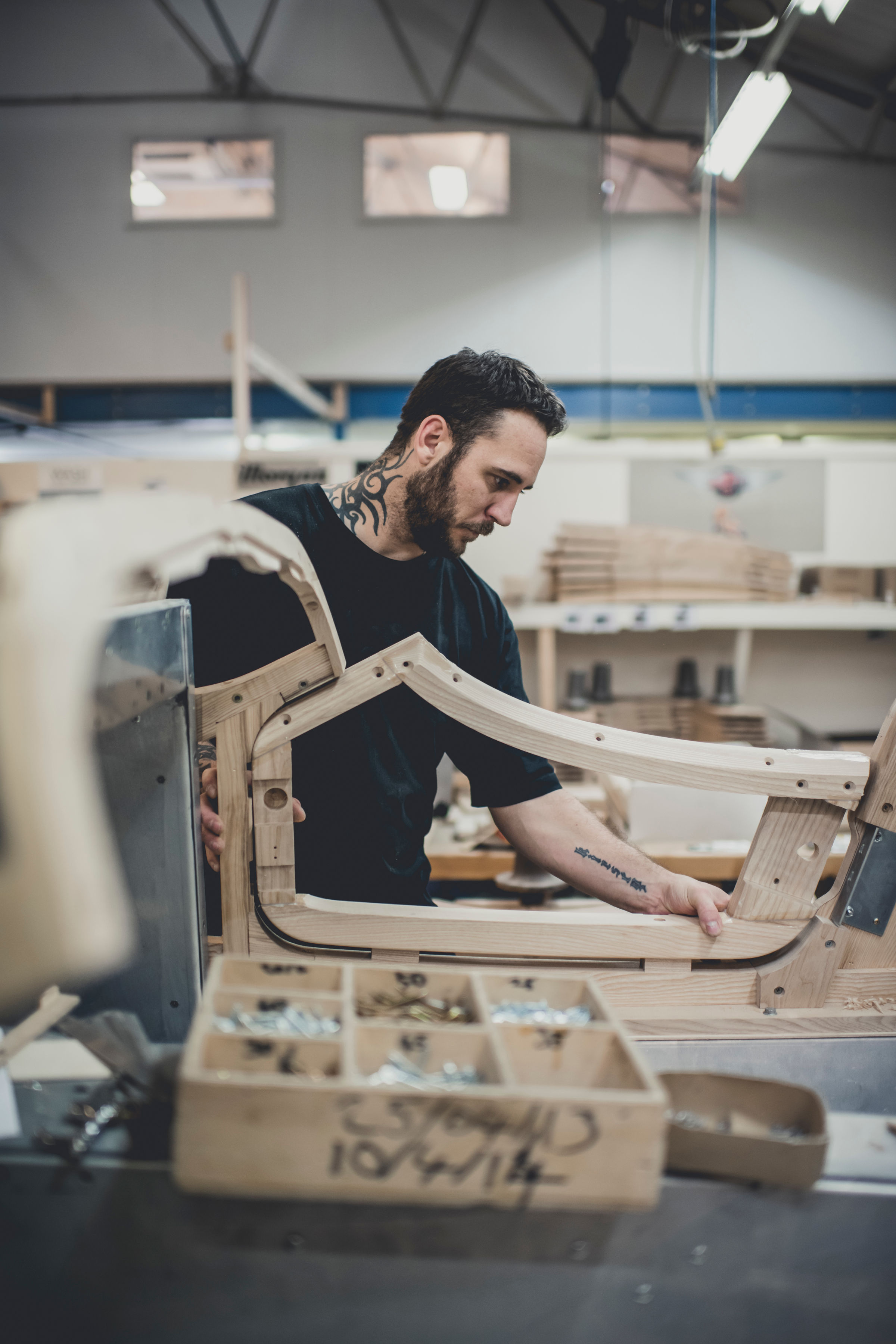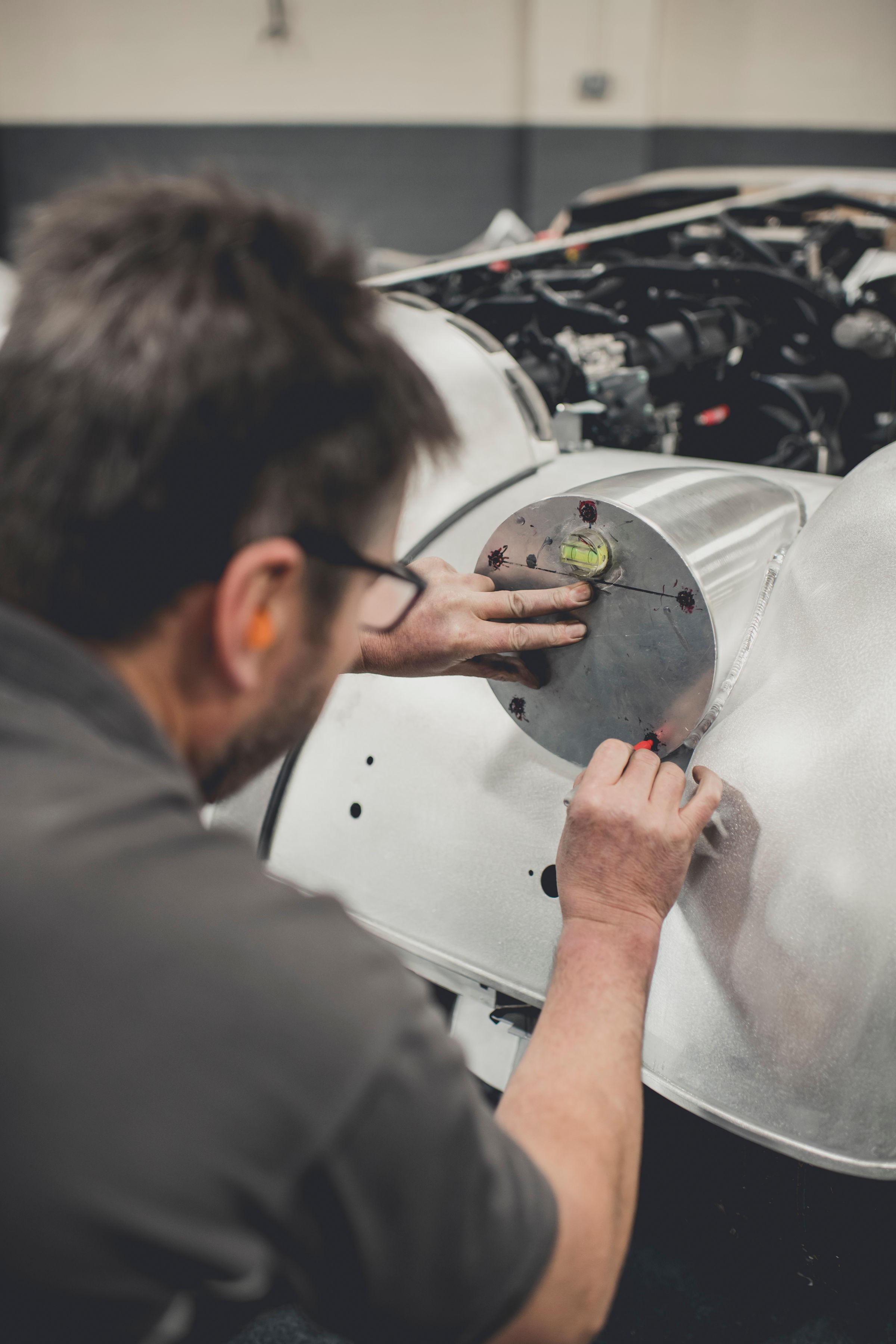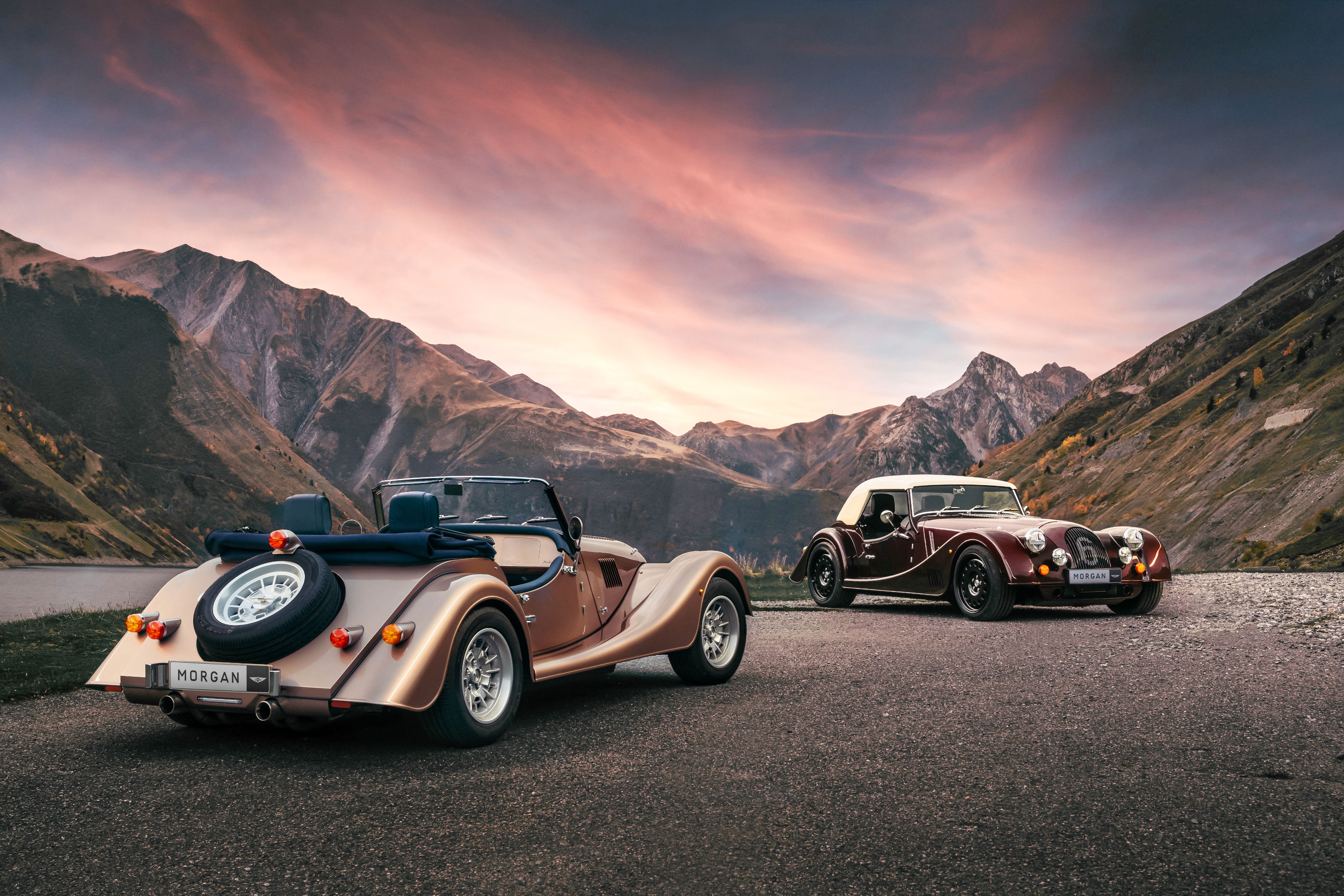
The Morgan Motor Company has been located in Malvern Link, Worcestershire, for over a hundred years, nestled at the foot of the surprisingly steep hills of the same name. It was these same hills that the firm’s founder, Henry Frederick Stanley Morgan, used as a testing ground for his first cars. These were light, efficient three-wheelers, with an innate sporting quality, although many of the pre-war cars were affordable runabouts and tourers, not out-and-out sports cars.

The first Morgan 4/4 (four wheels and a four-cylinder engine) was released in 1939, followed by a refined and uprated Plus Four model in 1952. The iconic Plus Four was released in 1950, and by the early 1960s had gradually evolved into a familiar and enduring form. Over 70 years, with diversions into Plus Eights (powered by a V8) and numerous variations, this is the car that continues to define Morgan in the modern mind.
Inside the Morgan Motor Company factory

Fast-forward to the present day and many of the company’s original brick workshops are still in existence, their floors worn uneven with activity. Some of the machinery looks distinctly antediluvian, with ancient presses, stampers and jigs abutting the more contemporary kit of car making.

‘We have a very wasteless attitude to manufacturing,’ Morgan’s head of design, Jonathan Wells, as he conducts a whistlestop tour through the process, from bonded aluminium chassis (made elsewhere in the UK) through to handcrafted Lincolnshire ash frame, over which the aluminium bodywork is hammered and bent into shape.

We’re here to sample the Plus Six, the top of the range Morgan that sits alongside the ‘entry level’ Plus Four and alongside the Morgan Super 3, the raw three-wheeler that leaves you open to the elements and is classified as a motorbike in the US market. After a visceral, rain-spattered blast in the latter, it’s time to get into the dry, leather-lined cabin of the Plus Six. So named for the six-cylinder turbo-charged BMW-supplied engine at its heart, the Plus Six is an impressive combination of two essential qualities of any sports car – light weight and raw power.

At just 1,075kg, the rear-wheel drive Plus Six makes the most of its 335hp. With a heavy right foot, it’s easy to unseat this car, although the nicely weighted, ultra-direct steering helps you snap it back in line without too much drama. Even though it’s slightly longer and wider than its Plus Four sibling (in order to accommodate the larger engine), the Plus Six is still a tight fit for two, with space behind the front seats to stow bags as well as a boot-mounted luggage rack.

As a long-distance GT, it’s not ideal – long stretches of autoroute would swiftly become a little wearing. Instead, think of the Plus Six as a way to enhance any journey, especially with the lightweight canvas roof stowed, no particular deadline to meet and a suitably winding (dry) road ahead.

Morgan definitely has a diverse and eccentric customer base, people who are willing to wait between three to six months for a car, and who value the process of visiting the factory and seeing hammer on metal in person. Plus Four and Six blend old and new unlike no other car, and even apparent anachronisms like the ash frame have their place. As Wells points out, it helps make the platform incredibly flexible, and materials use is pared to a minimum.

In contrast, the Super 3 is the first time the company has ever worked without wood, but even here there’s an inseparable combination of design and engineering. Nothing is superfluous. ‘Every component serves many different functions,’ says Wells, ‘which in turn serves the aesthetic.’ He points to the cast aluminium brackets that hold the Super 3’s headlights as well as serve as the engine bracing structure.

Inside, there’s military-grade weatherproof switchgear (the starter button is a missile release switch from the Tornado fighter jet), while the removable side storage panels feature a patented clip system that will hold everything from a GoPro to a suitcase. Shaping this car has been a labour of love for the company, and the Super 3 has found a ready audience of people willing to embrace its motorcycle-style attitude.

Things are changing at Morgan, albeit slowly. Wells is now the longest serving design chief at the company (although admittedly only its second), and in new Italian owner Investindustrial, it has the funding and ambition to do things a little differently. For decades, Morgan ploughed a solitary furrow, building bespoke cars for a select audience who prized individualism above all else.

Electrification poses a massive challenge to such a small manufacturer, of course, as do the safety requirements of essential markets like the USA, and the ever-increasing need for ADAS (Advanced Driver Assistance and Safety Systems) in new cars. The former is currently being explored, with prototypes like the recent Morgan XP-1 pointing convincingly towards a zero-emission future. The latter requires investment. Sure, there are loopholes, but the bottom line is that the sensor-festooned modern automobile with its lane-keeping assistance, emergency braking systems, and the like, seems completely at odds with the Morgan ethos to date.

For Wells and his team, currently based on an industrial estate a short drive away from the main factory, alongside practically every other desk job the company requires, these are opportunities as well as challenges. We’re shown page upon page of sketches and pointers to what’s coming in the near future – all currently under wraps - as well as an exclusive preview of an upcoming collaboration, one that will advance the Morgan aesthetic and its standing in the wider design community.

The British motor industry was once awash with small manufacturing outfits like Morgan, each catering to a precise niche and ensuring that jobs, skills, and benefits flowed into their surrounding communities. Economics and efficiencies mean that cars can no longer made this way, so Morgan’s survival is something to be cherished. The good news is that all the things that made the company so distinctive in the past will help it progress into a successful future.

For more information, visit Morgan Motor Company, Morgan-Motor.com



!["[T]he First and Fifth Amendments Require ICE to Provide Information About the Whereabouts of a Detained Person"](https://images.inkl.com/s3/publisher/cover/212/reason-cover.png?w=600)



